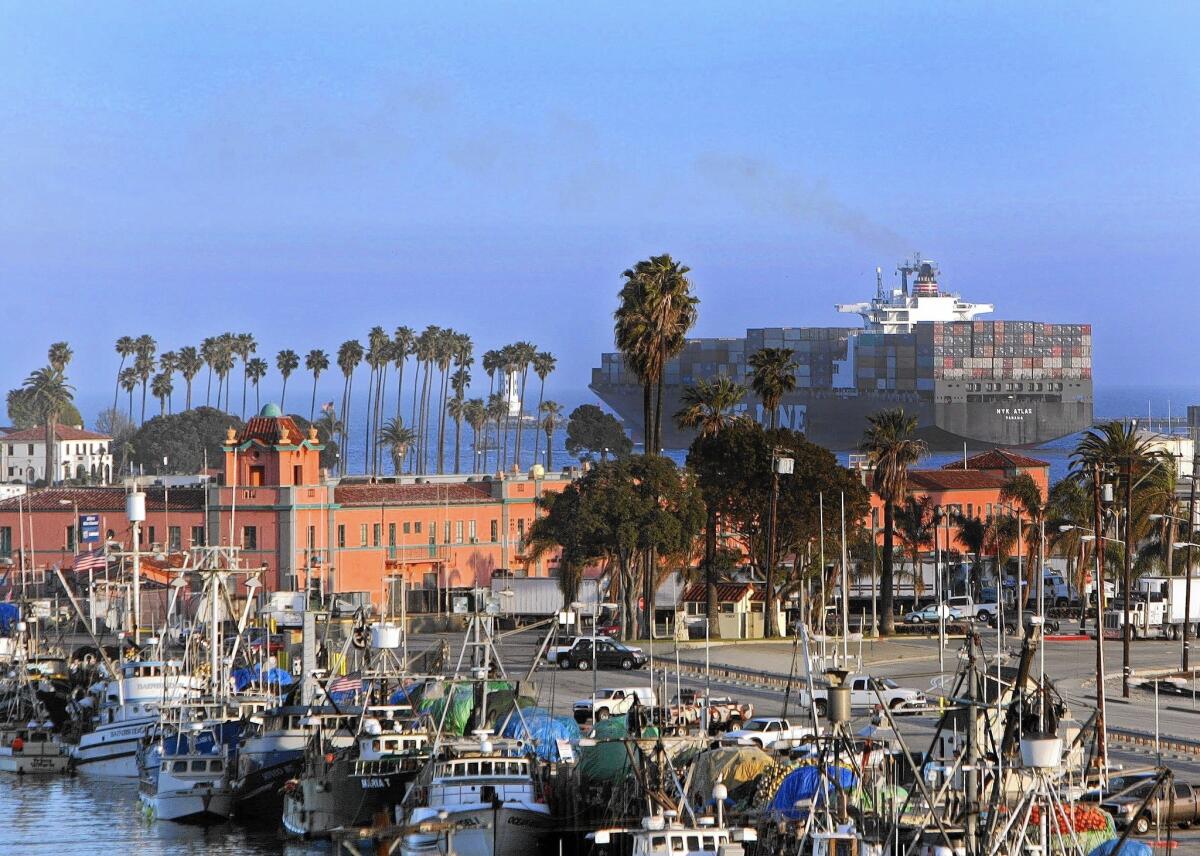Cancer risk from air pollution drops in Southern California

- Share via
Southern Californians’ cancer risk from air pollution has dropped 65% since 2005 but is still too high in many areas, regional air quality regulators said in a report released Thursday.
They attribute much of the improvement to tough state and local regulations, incentive programs and cleaner fuels that have slashed diesel emissions from trucks, ships and other vehicles on freeways and in freight corridors and ports.
The study by the South Coast Air Quality Management District measured levels of cancer-causing air pollutants to estimate the health risk they pose to 16.7 million people across a four-county region.
While the assessment shows remarkable progress, the region’s risk remains unacceptably high and is among the worst in the nation, air quality officials said.
The analysis found that exposure to dozens of toxic air contaminants could result in 418 cancer cases per 1 million people over 70 years, or a lifetime. That is down from an average risk of 1,194 cases per million found in the air district’s study of the region in 2005.
Health experts recommend a limit of 10 cancer cases per 1 million people over 70 years.
Current state guidelines underestimate the true cancer risk, air quality officials acknowledged, and are expected to be revised upward next year based on new science that shows breathing toxic substances has more serious health effects than previously thought.
The highest cancer risk, about 1,050 in 1 million, was detected in and around the ports of Los Angeles and Long Beach, a magnet for thousands of pollution-belching diesel trucks, ships and locomotives. Central Los Angeles and communities near freeways and rail lines also had some of the region’s highest risks.
The lowest cancer risk was found in central and southern Orange County and more lightly populated areas in southwest Riverside County and the Coachella Valley.
The greatest reductions occurred in the most heavily polluted communities, including neighborhoods near the ports, the study found.
Area ports have slashed emissions under a clean-air plan adopted in 2006 that bans old, dirty diesel trucks from port terminals and requires massive cargo ships to shut off their engines and plug into shore power. Many of those rules have since been adopted statewide.
Environmentalists and advocates for the region’s most polluted communities greeted the findings with qualified praise and calls for even more stringent emissions rules for industry.
“We shouldn’t plant a victory flag yet,” said Adrian Martinez, a lawyer for Earthjustice. “These levels are still unsafe to breathe in many parts of the Los Angeles region. And there are still inequities, primarily in low-income communities of color that are breathing the most polluted air.”
Barry Wallerstein, executive officer of the South Coast air district, said the study “documents a major success in battling air toxics, and at the same time is a call for a sustained effort to further reduce carcinogens in our air.”
Those cuts, he said, can be achieved through some of the same strategies to be used to meet federal standards for smog and fine-particle pollution and to combat climate change.
The main cancer linked to air pollution is lung cancer.
However, the number of actual cancer cases attributed to air pollution is small relative to other causes such as tobacco and alcohol use, said Julia Heck, an assistant professor of epidemiology at UCLA’s Fielding School of Public Health.
“Ultimately this is a positive finding, even if the absolute number of cancer cases prevented might not be that big,” she said.
The air district measured levels of 37 pollutants that are known to cause cancer, including benzene, lead, arsenic and diesel soot, at 10 air quality monitoring stations from July 2012 to June 2013. The assessment also used computer models and emissions inventories to estimate risks.
New guidelines on track to be approved next year by the state Office of Environmental Health Hazard Assessment would raise estimated cancer risks from toxic air contaminants to nearly three times their current levels.
But the state’s new method for calculating risk, which is based on scientific studies over the last decade, “does not change the fact that actual emissions and risk have declined,” the air district said in a statement.
Diesel exhaust remains the largest contributor to the problem, the air district’s analysis found, and is responsible for more than two-thirds of all air pollution cancer risk in the region. About 90% of the risk comes from mobile sources, including cars, trucks, cargo ships, locomotives and airplanes.
The drop in cancer risk shows that a variety of state and local programs to cut diesel pollution are paying off, said John Balmes, a professor of medicine at UC San Francisco and member of the California Air Resources Board.
“The air is cleaner in California because we have really clamped down hard on motor vehicle emissions and other transportation-related emissions,” he said.
The study encompassed a 10,700-square-mile area that extends across Los Angeles, Orange, Riverside and San Bernardino counties.
The air district study is the fourth of its kind since 1987. The last assessment found a 17% drop in cancer risk between 1999 and 2005.
[email protected]
Twitter: @tonybarboza
More to Read
Sign up for Essential California
The most important California stories and recommendations in your inbox every morning.
You may occasionally receive promotional content from the Los Angeles Times.










